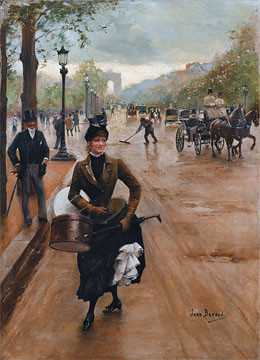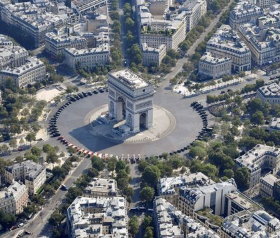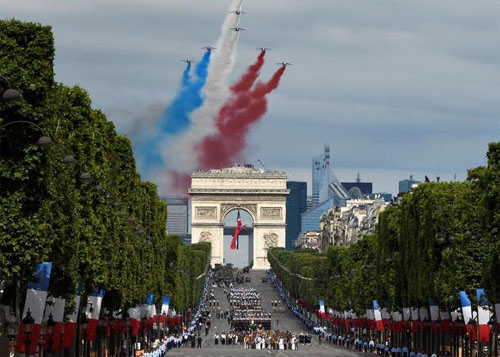Champs-Elysées facts. History

Created in the 17th century by Sun King, the Champs-Elysées in Paris are one of the most beautiful avenues in the world. The Champs-Elysées are the fifth most expensive retail location in the world after Via Montenapoleone in Milano, Upper 5th Avenue in NYC, New Bond Street in London, Tsim Sha Tsui in Hong Kong. Paris facts.
10 Champs-Elysées facts
1. The Champs-Elysées are one of the prime tourist destinations in Paris.
2. Their design is typical of the Haussmann urban planning of late 19th century that is the distinctive touch of the city.
3. The avenue runs through the 8th arrondissement in northwestern Paris, in what is called the golden triangle.
4. Since 1975, they have been the concluding destination of the Tour de France, the world's most famous cycling race.
5. Every year on Bastille Day, the French national holiday, the military parade passes down the Champs Eysees.
6. The avenue has many stores of international brands like Louis Vuitton, Sephora, Guerlain, Hugo Boss, Adidas.
7. Louis Vuitton is the most famous store in the avenue.
8. The Champs-Elysées are the world's fifth most expensive retail location.
9. Champs-Elysées stores have annual rents of 12500 euro per square meter on average.
10. Fouquet's is the most famous restaurant in the avenue.

Louis Vuitton are Champs-Elysées top store
Stay in top Champs-Elysées district hotel

Champs-Elysées hotel
Hôtel Barrière Fouquet's is the only hotel overlooking the Champs-Elysées. This 5-star hotel features a spa with a swimming pool and sauna, 3 bars and 2 restaurants, including the historic Fouquet's brasserie. All rooms have been decorated by top designers. Most rooms offer views of the Champs-Élysées, Avenue George-V or the hotel's interior garden. Champs-Elysées hotels.
Paris 75008 France

Hotel Barriere overlooks Champs-Elysées
Champs-Elysées history facts
In 1667, King Louis XIV commissioned the Champs-Elysées in the perspective of the Louvre, his palace in Paris. Lenotre, the designer of Versailles Gardens, cut a very long avenue across countryside meadows. The avenue was named Champs-Elysées in 1709. In Greek mythology, the Champs-Elysées are the place where heroes stay after death.
By the later years of the 18th century, the Champs-Elysées were a fashionable Parisian spot, as large houses and buildings, including Elysees Palace and the Hotel de Crillon, gave rise to impressive gardens and landscaping.
In 1836, workers finished construction of the Arc de Triomphe, the monumental arch at the west end of the avenue commissioned by Emperor Napoleon.
The Champs-Elysées were the fanciest avenue in the world in the second half of 19th and first half of 20th centuries.

Champs-Elysées in 1900 were fancy
Champs-Elysées geography
The Champs-Elysées are 1910 meter long and 70 meter wide. With the Avenue de la Grande Armee on the other side of Arc de Triomphe, they represent altogether a 7 kilometer straight line perspective from Place de la Concorde to La Defense business district west of Paris.
The Champs-Elysées are one of twelve avenues radiating from Arc de Triomphe, positionned as the hub of a star, a unique 1852 urban design by Georges Haussmann and Jacques Hittorff.

Arc de Triomphe is at the end of Champs-Elysées
Champs-Elysées shopping
Les Champs, as they are called by Parisians, may be the world most prestigious shopping avenue in the world.
The rents are extremely expensive as top French international brands fiercely compete to establish their flagship stores. Not able to compete on rents, most independent stores have closed down.
At walking distance from the Champs-Elysées, Avenue Montaigne and Rue du Faubourg Saint-Honore concentrate many of the most exclusive French fashion brand shops. The Golden triangle bordered by the Champs-Elysées, Avenue Georges V and Avenue Montaigne is the most luxurious and expensive in the city. Golden Triangle map.
Champs-Elysées shops are mostly dedicated to fashion and cars. Restaurants and cafés add up to the animation.
Detailed information on Champs-Elysées shops.

Sephora perfume store is 72 Champs-Elysées
Champs-Elysées events
Many first class events in the city take place in Champs-Elysées, a spectacular setting for any event.
The year is kicked off by the traditional New Year's Eve when many thousand people gather late into the night and drink Champagne on the avenue closed to car traffic.
July witnesses the traditional Bastille Day Military parade (July 14th) and the final stage of the world famous Tour de France cycling race.

Bastille Day Parade is in Champs-Elysées
Champs-Elysées detailed facts and history
The Champs-Élysées were originally only marshy and uninhabited land. Marie de Médicis decided to have a long alley lined with elms and lime trees beyond the Tuileries Palace, along the Seine: the Cours la Reine, inspired by the Florentine promenade of the Cascines, was opened in 1615. Around 1670, André Le Nôtre, gardener to Louis XIV, was responsible for continuing to develop these lands. It traced in the axis of the central pavilion of the Tuileries Palace, from the current Place de la Concorde to the current Rondpoint des Champs-Élysées, in the direction of the current Place de l'Étoile - a beautiful avenue bordered by land with alleyways of elm trees and grass carpets.
It was called the Grand-Cours to distinguish it from the Cours la Reine, or the Grande allée du Roule, the avenue de la Grille Royale (1678), the avenue du Palais des Tuileries (1680). The current name of the "Champs-Élysées" appeared in 1694 but was not definitively fixed until 1709 as evidenced by the royal accounts. This name was chosen after the mythological term "Champs-Elysées" (equivalent of paradise) probably to take the opposite view from the marshy origins of the avenue.
On April 2, 1810, it was through the avenue, adorned for the occasion of a fictitious triumphal arch, that the new Empress of the French, Marie-Louise of Austria, entered the capital. Later, Russian Tsar Alexander I, King Frederick William III of Prussia and Prince Schwarzenberg took their places in a gallery set up near the Elysée Palace to watch the parade of Allied troops. These bivouaced in the gardens which they left in a deplorable state. Louis XVIII had them rehabilitated and opened Avenue Gabriel. To continue the development, the Prefect of the Seine had all of the gardens assigned to the City of Paris by a law of August 1828: “Place Louis XVI and the so-called Champs-Elysées promenade, as they are designated in the plan annexed to this law, including the constructions owned by the State and with the exception of the two ditches in the Place Louis XVI which border the Tuileries garden. The said concession is made at the charge of the city of Paris to provide for the costs of surveillance and maintenance of the places designated above; to carry out, within five years, embellishment work up to a sum of at least two million two hundred and thirty thousand francs; to keep their current destination for the land granted, which may not be alienated in whole or in part ”.
The Champs-Élysées are nowadays an emblematic artery and a must-see tourist site, with its shops, cinemas and theaters, cafés and restaurants, famous monuments such as the Grand Palais or the Arc de Triomphe, its gardens. The avenue is also a place dear to the hearts of the French for having hosted large popular gatherings, on the occasion of historical or sporting events. Every July 14, the French National Day military parade takes place. The Champs-Elysées are also the place of arrival of the last stage of the Tour de France cycling and the place of departure of the Paris Marathon. For the end-of-year celebrations, since 1980, commercial brands have offered the world magical Christmas illuminations, over 2 kilometers long, organized by the Champs-Elysées Committee. Every December 31, like a springboard into the future, on New Year's Eve the Champs-Elysées are open to a million people who come to plunge into the hope of a happy New Year.
A wide range of leisure activities attracts crowds of all nations. Because they have been able to adapt to their times, the Champs-Elysées are today the flagship avenue and the example of perfectly mastered modernization.